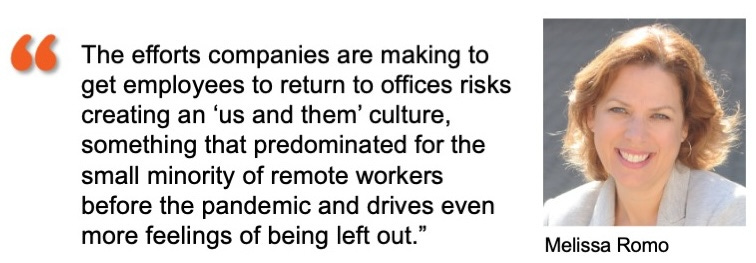Remote Work Is Here to Stay, So Build a Reinforcing Culture
Working at home has brought seismic change to our assumptions about the art of the possible.
By Rodger Dean Duncan
“Remote” work is nothing new to me. I’ve been doing it most of the time since 1973. Back then, high tech office equipment was an IBM Selectric typewriter with the bouncing ball. If you wanted to get really fancy, you could change the ball to type in italics.
I worked in Washington as a speechwriter in the Executive Office of the President. Many of the streets were torn up for construction of the subway system, so the traffic was awful. The commute was both nerve wracking and time consuming.
So, I suggested to my manager that I work at home. He laughed at me. The notion was so foreign he thought I was joking. But I finally convinced him to let me work at home one day a week.
That first day in my home office was glorious. But something seemed weird. Although I’d brought home what I estimated was eight hours of work, I finished in less than half that time. Then it occurred to me: I’d had no interruptions. Nobody dropped by to chat about the weekend ballgame. Nobody invited me to attend a meeting that had little or nothing to do with my current workload.
Fast forward to today. Millions of people around the globe are working at home either full time or at least part of the time. This has brought seismic change to our assumptions about the art of the possible.
Although much of that change was triggered by the Covid pandemic, there are other factors at play. Matt Mullenweg, a founder of WordPress site builder Automattic, noted at the start of the pandemic that Covid was “the remote work experiment nobody asked for.”
Someone with a particularly insightful perspective on the change is Melissa Romo, author of Your Resource is Human: How Empathetic Leadership Can Help Remote Teams Rise Above.
“Covid didn’t come with intent and planning,” she says. “We didn’t train leaders or workers to develop remote-compatible habits, which meant that remote work came at the cost of loneliness, burnout, and disengagement. The solution to those three is not to reverse remote work, but to learn how to create belonging and engagement through new management skills.”
While a lot of people are talking about burnout these days, Romo says home office monotony can lead to “boreout.” She explains the telltale signs of boreout, and how to prevent it.
“Boreout describes the sensation you have when your work has lost all meaning and you show up in body but not in heart or mind,” she says. “Remote work makes it harder to get the feedback and the association we have with colleagues that’s important to feeling like we are doing meaningful work. If tasks suddenly feel monotonous, repetitive and are difficult to focus on, it’s likely we have disconnected from the meaning of what we are doing.”
Romo, who’s worked with companies like American Express and Procter & Gamble and has led remote teams for more than a decade, says excessive amounts of time in a home workspace can under-stimulate people and lead to boredom.
“Preventing boreout comes down to managing an employee’s workload and output closely,” she says, “drawing close associations between what an employee is doing and the mission and vision of the company.” She says managers should ensure that remote employees have the ability to work in varied environments and that this practice is encouraged by the company as a wellbeing practice, versus something employees do on their own “under the radar.”
Romo highlights five emotional pitfalls of remote and hybrid work: boredom, depression, guilt, paranoia, and loneliness. Boredom and loneliness don’t seem terribly surprising. But what about depression, guilt, and paranoia. How—and why—do these emotions come into play?
“Paranoia for remote workers is simply the notion that they are ‘out of sight, out of mind’—the nagging sensation that things are happening without them,” she says. “Even though more employees are returning to offices, the population of remote workers will remain far above what it was pre-Covid. The efforts companies are making to get employees to return to offices risks creating an ‘us and them’ culture, something that predominated for the small minority of remote workers before the pandemic and drives even more feelings of being left out.”
Romo says guilt for remote workers has many layers: guilt about having a work arrangement that others don’t or can’t have; guilt toward themselves about not being able to simultaneously manage the demands of home and caregiving when they are remote; guilt about any amount of time offline, especially if one’s manager is online, even in another time zone.
As far as depression is concerned, Romo says, a multi-country review of studies measuring remote work’s impact to mental health for the 20 years prior to the pandemic indicated that remote work itself does not cause depression. “But what becomes problematic for a remote worker,” she says, “is the likelihood that their isolation creates fertile ground for rumination and worry during a depressive period, such as a divorce, death, medical diagnosis or other significant life trauma.”
Organizational psychologists have said one of the few silver linings of the pandemic is that more people at leadership and management levels are starting to recognize that if you don’t care about people’s quality of life, you don’t get quality work. Romo agrees with that perspective.
Keep reading with a 7-day free trial
Subscribe to LeaderSHOP to keep reading this post and get 7 days of free access to the full post archives.



